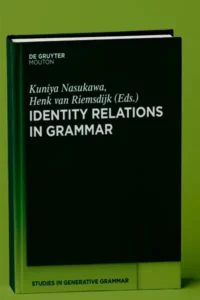Identity Relations in Grammar few concepts are as ubiquitous in the physical world of humans as that of identity.
Identity Relations in Grammar PDF
Few concepts are as ubiquitous in the physical world of humans as that of identity. Laws of nature crucially involve relations of identity and nonidentity, the act of identifying is central to most cognitive processes, and the structure of human language is determined in many different ways by considerations of identity and its opposite.
The purpose of this book is to bring together research from a broad scale of domains of grammar that have a bearing on the role that identity plays in the structure of grammatical representations and principles.
Needless to say, the notion of identity as used here is an intuitive notion, a pre-theoretical one. We do not really know that we are talking about the same thing when we talk about referential identity and haplology, even though both are discussed in terms of some notion of identity.
Bringing together a variety of studies involving some notion of identity will undoubtedly bring us closer to an understanding of the similarities and differences among the various uses of the notion of identity in grammar. Ultimately, many of the phenomena and analyses discussed in this book should probably be evaluated against the background of Type Identity Theory to see if a more precise notion of identity can emerge.
Some ways in which identity-sensitivity manifests itself are fairly straightforward. For example, reduplication (cf. Raimy 2000 and many others) in morpho-phonology creates sequences of identical syllables or morphemes. Similarly, copying constructions in syntax create an identical copy of a word or phrase in some distant position.
This is typically true, for example, of verb topicalizations such as those frequently found in African languages such as Vata (cf. Koopman 1984). In such constructions (often referred to as ‘predicate clefts’) the verb is fronted, but is again pronounced in its source position, (cf. Kandybowicz 2006 and references cited there).
Such constructions as well as the observation that wh-copy constructions are frequently found in child language (see for example McDaniel, Chiu and Maxfield 1995), have also contributed to the so-called copy theory of movement according to which a chain of identical copies is created whose (non-)pronunciation is determined by principles of spell-out.
Alternate theories of movement such as remerge resulting in multiple dominance largely
avoid the identity problem, see Gärtner (2002), who observes that the copies under the copy theory are not formally identical at all.
In many cases, however, what is at stake is not the coexistence of identical elements in grammatical structure but rather its opposite, the avoidance of identity, a term due to Yip (1998). Haplology, the deletion of one of two identical syllables or morphemes, is a case in point.
In addition to deletion, there are other ways to avoid sequences of two identical elements (“XX”): insertion of an epenthetic element (XX→XeX), dissimilation (XX→XY), creating distance (XX→X…X) or fusion (AA→Ā).
In phonology and morphology, there is an abundance of identity avoidance phenomena, and some major principles such as the Obligatory Contour Principle (OCP, cf. McCarthy 1986) are instrumental in accounting for them. But OCP-like principles have also been argued to be operative in syntax (cf. Van Riemsdijk 2008 and references cited there).


